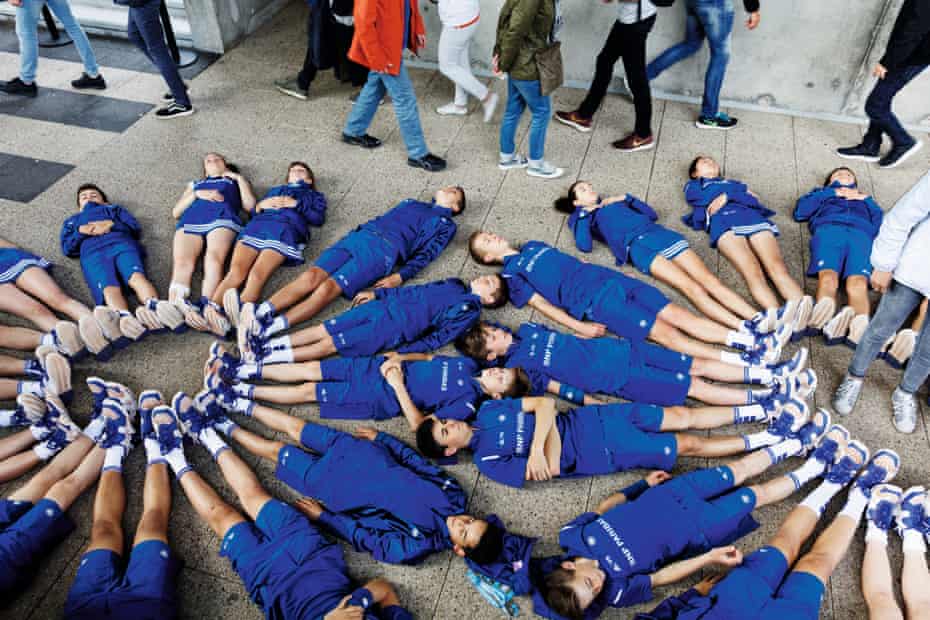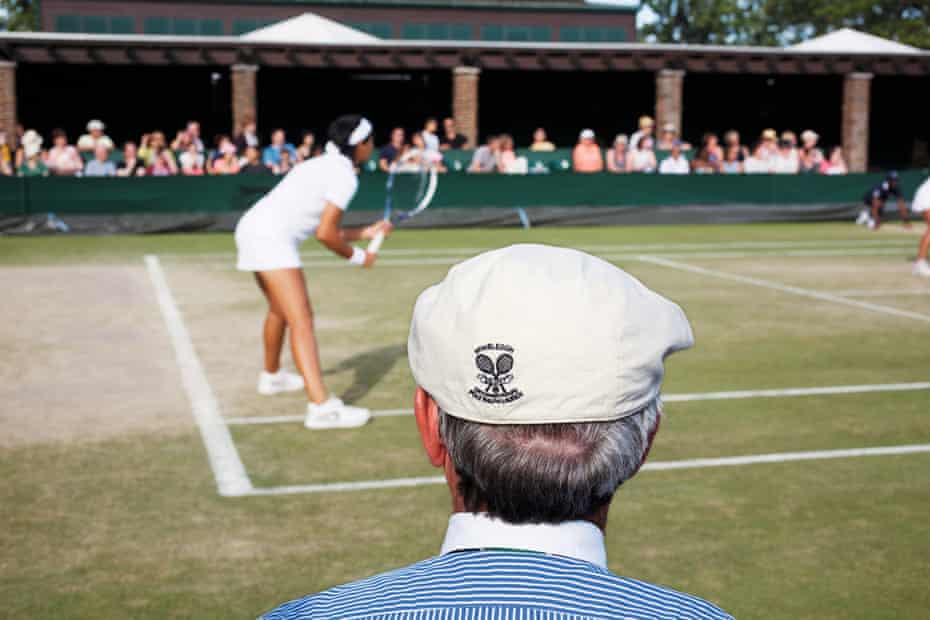It’s the morning after the night before at the US Open and the sports sections contain images of triumph and defeat. Ecstatic Emma Raducanu lying prostrate on the tennis court. Bereft Novak Djokovic sobbing into his towel. The photographer Martin Parr would have liked to have watched the finals, but he’s been unwell and incapacitated, stuck on one floor of his house with the TV on the other. He briefly considered watching on his laptop but it just seemed too much bother. “I like tennis tournaments,” he says, a little sheepishly. “That doesn’t necessarily mean that I like tennis per se.”
In this, one suspects, he is not alone. Parr’s new book Match Point offers a vivid globe-hopping tour of the four grand slam tournaments, bounding from Melbourne to Paris to London to New York and mingling with the spectators as they ogle their iPhones or sunbathe on the grass or guzzle iced coffee at the refreshment stand (the book was commissioned by the Italian coffee firm Lavazza). Most people, he points out, visit Wimbledon in the same spirit that they would attend Ascot or the Chelsea flower show: it’s a social event, an excuse to dress up. They might spend the entire day in the grounds at SW19 and go home without seeing a single ball being served.
Parr suggests we meet at the office of his foundation in Bristol. He’s not in good health and can’t travel far. At the age of 69, the photographer has spent the bulk of his life on the move, bustling from one social gathering to the next, shooting on the run, jaywalking into human traffic. But these are difficult times: for the world and for him. Lockdown was a drag in that it kept everybody indoors. But then in May he was diagnosed with cancer and is now having chemotherapy. He nods at his walking frame and barks a short laugh. “Hopefully, I can get rid of this thing in a few months or so,” he says. “But it might be that I’ll need it for the rest of my life.”

We sit on the couch and turn the pages of Match Point. It feels like peering into a bygone age. Parr took these pictures back in 2017 and 2018, when punters could pack into Flushing Meadows and Roland Garros like sardines, and it seemed that pretty much everyone was sipping from the same plastic straw. He tells me that each of the venues has its own distinct character. “Wimbledon is the most interesting because of the queue and the fact that people camp all night. Melbourne’s good as well. Lots of social activity. Always very hot. People carry little fans to cool down.” He snorts when we get to Paris: “I can’t say that Roland Garros is the least interesting, but it probably is. Too much tennis for my liking. They take it very seriously there.”
Let the official photographers crouch at the sidelines and shoot the superstar athletes. Parr was there with a different brief. His book contains one double-page spread of Rafael Nadal signing autographs. Elsewhere, though, the top players appear in virtual form, pixelated on giant TV screens or plastered on hoardings beside the coffee stall. It’s an approach that turns the likes of Andy Murray or Roger Federer into the equivalent of wallpaper or background muzak. The punters stroll by with their attention directed elsewhere. That’s what interests Parr: he couldn’t give a stuff for the stars. “I didn’t really watch any tennis at all. It takes too long. You get involved in a match and suddenly three hours have passed.”
In his time, Parr’s racked up more than 80 photobooks and over 100 exhibitions. But his most famous work remains 1986’s The Last Resort, with its retina-frying vignettes of working-class New Brighton, the seaside resort on Merseyside. Parr ran amok on the shingle, at the arcade, inside the chippy and whipped up a hyperreal vision of Thatcher-era Britain at play that was so bracing, so tangy that you could almost smell the vinegar and filled nappies. It was a breakthrough collection that established his reputation and set the trajectory of his career. “Basically, my one big project is what the rich western world is up to in its leisure time,” he says. “That’s my project – but I’m a part of it, too, I’m not exempt.”
Parr’s photography is driven by a fiery ambivalence about the UK. He loves it and he hates it, sometimes within the same frame. “I mean, I’m your classic remoaner, pissed off that we voted leave. That’s the aspect of Britain that annoys me. But then there are also many other aspects that I love, like Radio 4 and the village fete.” He barks a laugh. “Which is probably full of Brexiters.”

While Parr’s area of interest remains constant, he’s had to find new locations to haunt and fresh targets to hunt. He’s naturally drawn to big public spaces: crowded beaches, high streets, shopping centres. It’s just that these days there are fewer people about, while those who still go out appear to have grown camera-shy. “It’s becoming more and more difficult to photograph on the street,” he explains. “People are more suspicious. A lot of them think it’s illegal and I have to keep telling them that it’s not.”
So having your photo taken used to be a nice novelty, whereas it’s now seen as a violation? “Well, you can’t make a sweeping statement like that,” he says, bristling. “That’s always what you journalists do. But certainly over the years, it has become more difficult. When I think back to the early 80s, when I was photographing kids on the beach at New Brighton, no one batted an eyelid. If I did that now, I’d be pounced on. People are more wary. The general drift is towards suspicion. That’s why I like photographing events these days. Tennis tournaments, art fairs, fashion shows. If people are engrossed in what they’re doing, they have less time to respond.”
When The Last Resort was first published, he was accused of exploiting his subjects, of holding a fairground mirror up to everyday British life. But he feels that such criticism is not only pious, it’s also built on false assumptions. Truth is subjective. Photography has to entertain. Anyone who claims otherwise is simply kidding themselves. “But there’s still this old-fashioned humanism that persists in some quarters. This idea that, ‘Oh, I photograph war in order to end war.’ But you never will. It’s impossible. All we are doing is creating entertainment. Hopefully, it will have a serious message, too, but it’s not obligatory. Unless you make an entertaining picture, no one’s going to pay attention.” He picks up Match Point. “Is this entertainment? I suppose it is on one level. I’m not sure what you’d learn about tennis from this book.”

I worry he’s downplaying his achievements, but he insists he’s not. Parr believes in the power of the still image. He says it’s the index of our lives, the art-form of our time. “Every day you go out hoping that you might get one of those magic pictures, those iconic pictures. You rarely do. But that’s what keeps you going.” How many times does he think that he has? “Over my lifetime?” He grimaces. “Maybe 60 or 70. And that’s not bad going. It really isn’t.”
The past 18 months have, he admits, been especially hard. He thrives on crowds and colour: the hustle and bustle of bodies inside a shared space. But the high streets are struggling and the department stores keep closing and he worries that the ripple effect of Covid could change the country for good. So he finds himself at a crossroads. He doesn’t especially want to shoot ghost towns, but there hasn’t been much else going on. He had several plans for the summer, but he got ill. “At this point, I just want to continue,” he says. “I hope to get back to some proper photography next year. Hopefully sooner. I was in St Ives over the bank holiday and I had a mobility scooter, so that was fun.”
St Ives that weekend, he remembers, was just like old times. Heaven on earth. Completely rammed. Parr wove through the crowds on his scooter, snapping pictures on his phone. He says: “Suddenly I’m a disabled photographer. And that doesn’t do any harm. It’s probably less threatening. It makes a nice change from being an old white middle-class man.”




